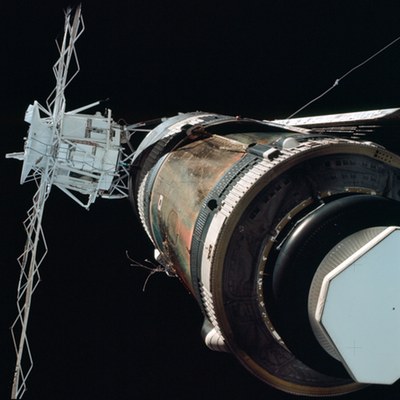Those magnificent spooks and their spying machine: The spies help rescue Skylabby Dwayne Day
|
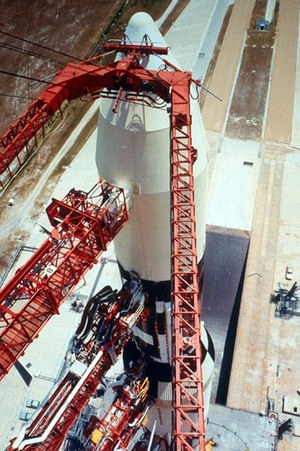 Skylab atop its Saturn V launch vehicle in May 1973. (credit: NASA) |
Wounded bird
On May 14, 1973, NASA launched the Skylab Orbital Workshop atop its last Saturn V to fly. During liftoff the workshop’s meteoroid shield broke loose and ripped off one of its two main solar panels. The problems were immediately apparent to NASA technicians monitoring the launch. Telemetry went bad soon after the ignition of the mighty Saturn’s second stage, and ground-based radars detected multiple pieces of debris coming off of the station. Skylab entered orbit and jettisoned its large payload fairing as planned, but it was severely damaged.
NASA was aware of some of the damage to their expensive space station. Even without cameras aboard Skylab, they had enough data to figure out the broad outlines of the problems. For instance, temperature sensors inside of Skylab indicated that it was very hot, a clue that the exterior insulation had been ripped off. The temperature was so high that ground controllers worried that some plastics inside the station might start to melt. The spacecraft still responded to commands from ground controllers to shift orientation and minimize solar heating, but it would have to be repaired before it could enter service—assuming that it could be repaired at all.
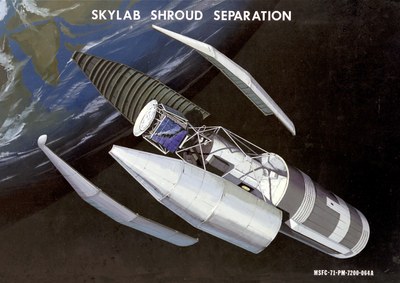 Artist impression of the jettison of the Skylab payload fairing upon reaching orbit. By this time, Skylab had been damaged when its micrometeoroid shield had torn off, along with one of its main solar panel wings. (credit: NASA) |
But with limited data it was difficult to determine a path forward. More data is always useful when dealing with unknown situations, and soon an offer of help came from an unusual corner, the National Reconnaissance Office (NRO), which managed and operated the nation’s top secret intelligence collection satellites.
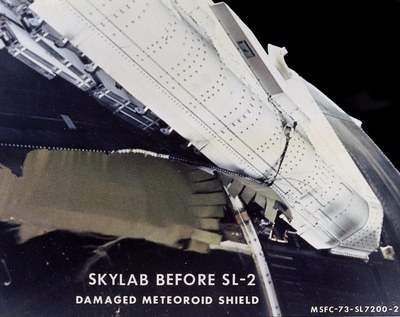 Close up image taken by the astronauts of damage to the Skylab. (credit: NASA) |
An offer of help
Major General David Bradburn, who was then the head of the Office of Special Projects, one of the NRO’s component offices and based in Los Angeles, quickly proposed that a GAMBIT-3 spacecraft, also known as the KH-8, readying for launch on May 16, be used to take a photograph of Skylab to assist NASA in planning a repair mission. The manned Skylab 2 mission, which had now become a repair mission, was scheduled to launch on May 25. That short turnaround time meant that the first phase of the GAMBIT’s photographic mission would have to be cut short in order to return the photos earlier so they could be used for planning the repair mission.
According to Bradburn, who spoke about the incident during an Air Force history symposium in 1995, he made the argument that Skylab was an American project and it was in the best interests of the nation that it not fail. This justified using an intelligence satellite to help save it, even if that undermined some of the intelligence collection. Bradburn’s proposal was approved by his superiors in the NRO and, presumably, by the Director of Central Intelligence and the Secretary of Defense.
Bradburn was able to propose this mission because, for approximately six months, a group of junior Air Force officers in the Special Projects Office had been developing computer algorithms for using a GAMBIT-3 to photograph Soviet spacecraft. Their effort had been instigated by Soviet tests of an anti-satellite capability that the Soviets had declared operational in February 1973. They wanted the capability to take a photograph of a Soviet ASAT vehicle if one ever approached an American spacecraft. Because the computer programs were ready, the NRO was able to respond quickly to the Skylab problem—something that Bradburn was able to tell his superiors, and undoubtedly contributed to them approving the mission.
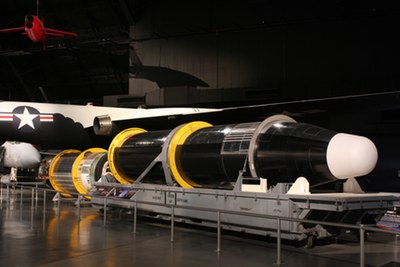 A GAMBIT-3 satellite on display in the National Museum of the United States Air Force. (credit: D. Day) |
The first GAMBIT-3 had launched in 1966 while the less-powerful GAMBIT-1 was still in service. It had a 175-inch (4.4-meter) focal length, and a camera that operated by pulling a large strip of black and white film past a narrow slit. The exposed film was then wound up at the front of the spacecraft inside a “bucket” protected by a heat shield. During a normal mission, when the film was all exposed after several days of operation, the bucket was ejected, fired a small retro-rocket, and reentered Earth’s atmosphere. After deploying a parachute, it was captured in mid-air by an Air Force cargo plane hundreds of kilometers from Hawaii. At that point the satellite was junk and was commanded to reenter and burn up.
By 1969 the NRO had added a second bucket to the spacecraft. This allowed it to take pictures, return them to Earth, and then go into sleep mode for awhile before waking up to take some more pictures. The primary benefit of this second bucket was to extend the lifetime of a valuable piece of equipment, although it did offer the opportunity to return pictures faster in a crisis situation without ending the entire mission early.
Bradburn was not supposed to talk about any of this in 1995. He was not overly specific about the details, never mentioning the name of the still-classified GAMBIT program, for example. But the intelligence community did not acknowledge that it used satellites to take pictures of other satellites, even though the NRO first developed that capability with an earlier satellite program known as CORONA in the mid-1960s, and an offshoot of the Program 437 ASAT had also developed satellite imaging equipment. Bradburn’s remarks in 1995 were not repeated in the official proceedings of the conference (although I was there at the public session, and later wrote about what he had said).
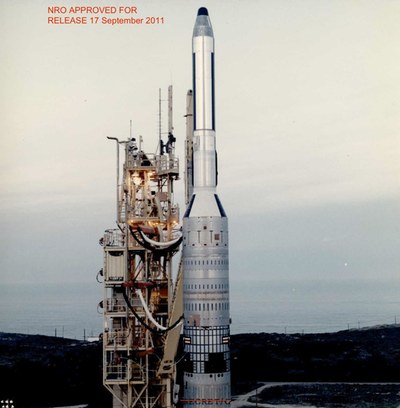 GAMBIT-3 reconnaissance satellite atop its Titan III-Agena D rocket prior to launch. (credit: NRO) |
Launch of the black bird
GAMBIT-3 number 38 launched as planned atop a Titan III-Agena D rocket from Vandenberg Air Force Base in California on May 16, 1973. It quickly reached orbit and began operating its camera, probably taking photographs of targets inside the Soviet Union prior to reaching proper position to take a photo of Skylab.
According to independent satellite observer Ted Molczan, records from that era show that the closest approaches of the GAMBIT-3 and Skylab took place on May 18 and 19. The GAMBIT’s first satellite reentry vehicle de-orbited and was recovered over the ocean on May 21, so probably the last possible imaging day was on May 20. Normally, a GAMBIT-3 would have operated its powerful camera taking photos of targets in the Soviet Union for up to a week or more before returning its first reentry vehicle and then going into a sleep mode for several weeks.
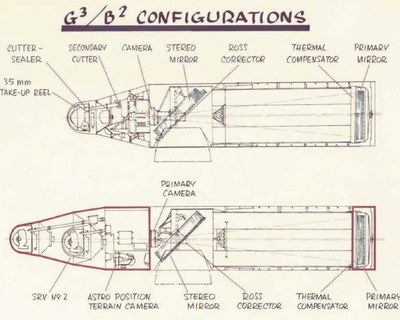 Comparison of single and dual-bucket GAMBIT-3 reconnaissance satellites. (credit: NRO) |
The photograph—there was probably only one because of the way the camera operated—has not been declassified. According to one person who saw the black and white image, the Skylab was only a small spot in the frame. It was also slightly blurry but still identifiable, and the photography was apparently still useable for NASA’s rescue mission.
Jim Oberg, who used to support NASA space missions, and is an expert on orbital rendezvous, notes that the Skylab rescue mission would have been in advanced planning stage by the time the GAMBIT-3 imagery was returned to Earth. “There don’t seem to be any indicators that major changes were made to these plans after obtaining the imagery,” Oberg wrote in an email. “The key feature that such imagery might have been able to contribute deals with the existing Skylab rescue plan.”
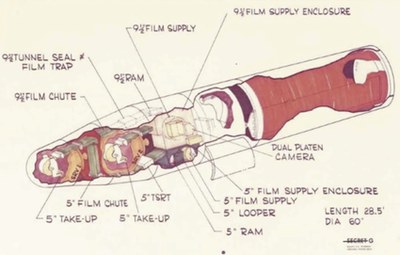 Cutaway of the GAMBIT-3 reconnaissance satellite with its powerful internal camera. This illustration depicts a later version than the one used for the Skylab imaging. (credit: NRO) |
The plan was to fly the Apollo Command/Service Module alongside and have a crewman standing inside the Apollo try to pull the remaining solar panel wing loose with a grappling hook. “The critical missing data was the degree to which other torn off debris might still have been dangling outside, potentially flopping around right in the same volume through which the Apollo and its spacesuited harpooner would have to operate,” Oberg explained. “Knowing in advance that the space alongside Skylab appeared clear of large objects would have validated existing plans and lessened the need for elaborate contingency plans. In such a situation, from NASA’s point of view, no news—or rather, ‘news of nothing’—was good news.” As it turned out, the astronauts used another method to free the stuck solar panel in one of the most daring, and underrated, space missions ever flown.
Considering that the GAMBIT strip camera had been designed to photograph a moving ground target, matching the film speed to a moving spacecraft in an entirely different orbit must have been challenging. But the mission contributed to the rescue of a billion dollar space project—and it also demonstrated that not even Soviet satellites could hide from the prying eyes of American spysats.
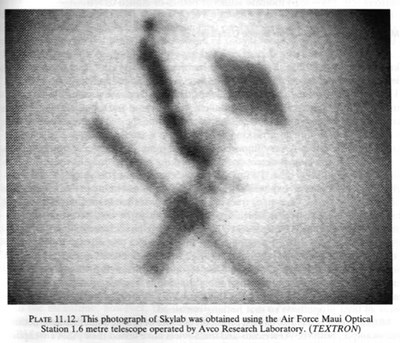 Image of Skylab taking by the an Air Force telescope atop the Haleakala volcano in Maui after the repair mission. This is a view from below the station, with the deployed solar panel visible at upper right. (source) |
RSEN
Later, an Air Force telescope took a blurry image of the operational Skylab. But after this event, the United States further developed so-called satellite-to-satellite (or “sat-squared”) imaging capability. According to one person familiar with the subject, a later GAMBIT-3 mission took an incredibly detailed photograph of Kosmos 1267, an unmanned spacecraft that rendezvoused and docked with the Salyut-6 space station in spring 1981. The last GAMBIT-3 was launched in 1984. But by late 1976 the NRO began operating a new series of satellites known as the KH-11 KENNEN, which did not require film and could transmit their imagery to a ground station. According to some reports, the KH-11 was used to image early space shuttle missions to make sure that they had not lost thermal protection tiles. The intelligence community remains very tight-lipped about this.
Satellite-to-satellite imagery was placed in a special security classification compartment known as “RUFF SENSITIVE,” or “RSEN” for short. In addition to sat-squared imagery, RSEN included other unusual and exotic capabilities demonstrated by American reconnaissance satellite cameras. Today, some non-American satellites have demonstrated the ability to photograph or image with radar other satellites, so the technology has clearly proliferated. For example, in 1998, the French Spot-4 satellite photographed the European Space Agency’s ERS-1 satellite. And the United States has developed powerful ground-based imaging telescopes that can produce incredibly detailed images of orbiting satellites, foreign and domestic.
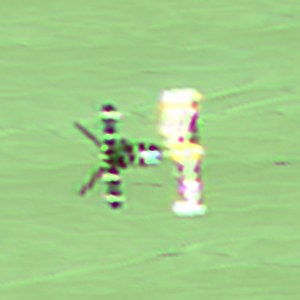 Image taken of the ERS-1 satellite by the Spot-4 satellite in 1998. (source) |
The GAMBIT-3 program was declassified in September 2011 and the National Reconnaissance Office released significant amounts of information about its technology and its operations, including several official histories of the program as well as some imagery, degraded so as to not show its impressive capabilities. The official histories had some deletions, however, including a section that most likely referred to the Skylab incident. It may be a long time before that information, and the imagery, is released.
But Skylab went on to great success, and perhaps some people within the intelligence community are today honoring their predecessors who helped it along four decades ago.
